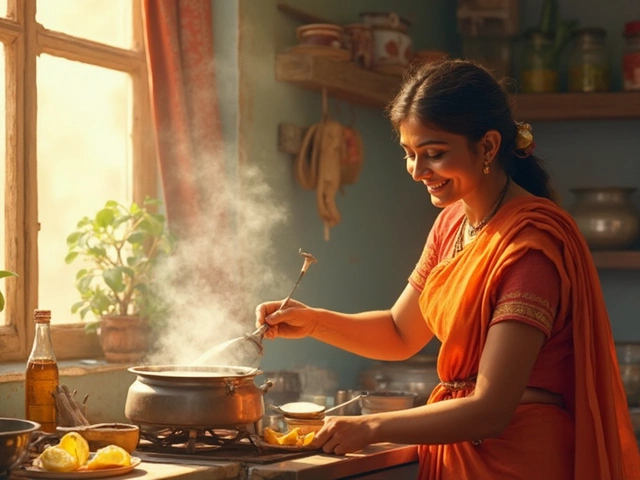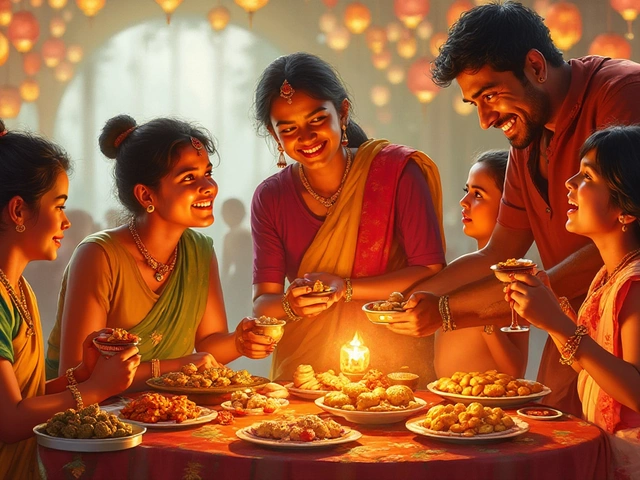Dal Tadka Spice Level Calculator
Adjust the heat level for your dal tadka recipe. The default setting is medium heat (2 chilies).
Your Dal Tadka Recipe
Dried red chilies: 2 chilies
Heat level: Medium
For mild: use 0-1 chilies. For hot: use 3 chilies. Adjust according to your preference.
If you’ve ever wondered what a basic Indian dish looks like, you’re not alone. Many people think Indian food means spicy curries, complex spice blends, and hours in the kitchen. But the truth? Some of the most loved Indian meals are the simplest ones-made with just a few ingredients, cooked in under 30 minutes, and eaten in homes across the country every single day.
Dal Tadka: The Everyday Staple
Dal tadka is the most common basic Indian dish you’ll find in homes from Delhi to Chennai. It’s not fancy. It doesn’t need fancy tools. You don’t even need a pressure cooker-though many use one. All you need is lentils, water, salt, turmeric, garlic, cumin seeds, dried red chilies, and a splash of ghee or oil.
Start by rinsing half a cup of yellow split lentils (masoor dal or toor dal). Boil them with two cups of water, a pinch of turmeric, and a little salt until they’re soft and mushy-about 20 minutes. While that’s cooking, heat a teaspoon of ghee in a small pan. Add half a teaspoon of cumin seeds. Wait until they sizzle and pop. Toss in one or two dried red chilies and two crushed garlic cloves. Let them fry for 15 seconds until the garlic turns golden. Pour this sizzling mix over the cooked dal. That’s it. That’s dal tadka.
This dish is served with plain steamed rice or warm roti. No sauce. No garnish beyond the tadka. No fancy spice mix. Just flavor built layer by layer, slowly, in a quiet kitchen. Millions of Indians eat this for lunch or dinner. It’s comfort food. It’s protein-rich. And it’s the first thing most Indian kids learn to make.
Why Dal Tadka Is the Real Basic Dish
Not all Indian dishes are created equal when it comes to being "basic." Biryani needs basmati rice, saffron, and meat. Chole bhature requires fermented dough and chickpeas soaked overnight. But dal tadka? It’s made from ingredients you can find in any Indian pantry, even in small villages without supermarkets.
It’s cheap. It’s filling. It’s vegetarian and naturally gluten-free. It keeps well in the fridge for days. And it’s nutritious-lentils are packed with fiber and plant-based protein. In fact, the World Health Organization lists lentils as one of the most sustainable and accessible protein sources in developing countries. India eats over 15 million tons of lentils every year. Dal tadka is the reason.
Compare that to other dishes. Aloo gobi? Needs potatoes and cauliflower. Chana masala? Needs chickpeas and tomatoes. Dal tadka? Just lentils and spices you already have. That’s why it’s the baseline. The foundation. The dish you make when you have nothing else.

What Makes It Taste Like India?
The magic isn’t in the ingredients-it’s in the technique. That sizzling tadka? That’s called tempering. It’s how Indian cooking unlocks flavor. Cumin seeds don’t taste like much raw. But when they hit hot oil or ghee, they release oils that smell like earth and smoke. Dried chilies turn from bitter to fragrant. Garlic turns sweet.
This step is non-negotiable. Skip the tadka, and you’re just eating boiled lentils. Add it, and suddenly you have something warm, aromatic, and deeply satisfying. It’s the same trick used in sambar, rasam, even vegetable stir-fries. Once you understand tempering, you understand Indian home cooking.
Some families add a pinch of asafoetida (hing) to the tadka. It’s strong-smells like sulfur when raw-but when cooked, it adds a savory depth that’s hard to describe. Others add a squeeze of lemon at the end. Both are optional. The core recipe? Still just dal and tadka.
How to Eat It Like a Local
In most Indian homes, dal tadka isn’t a side dish. It’s the main event. You spoon it over a plate of steamed rice. Mix it in. Let the rice soak up the broth. Eat it with your fingers-right hand only, if you’re following tradition. No fork needed. No knife. Just your fingers, a bit of warmth, and the soft, creamy texture of lentils mixed with the crunch of fried spices.
It’s common to serve it with a side of plain yogurt or a quick pickle (achar). But even without those, it’s complete. You don’t need a salad. You don’t need bread unless you want to scoop it up. And you definitely don’t need a restaurant.
This is how most Indians eat their meals: simple, balanced, and centered around one well-made dish. Not five. Not seven. One. And that one dish? It’s often dal tadka.

What to Do If You Don’t Like Lentils
If you’re not a fan of lentils, dal tadka might not be your thing. But that doesn’t mean you can’t find a basic Indian dish you’ll love.
Try chana masala-spiced chickpeas cooked with onions, tomatoes, and garam masala. It’s a little more complex than dal, but still simple. Or go for aloo sabzi-potatoes sautéed with turmeric, cumin, and a little chili. Both are vegetarian, quick to make, and use pantry staples.
Or if you want something with texture and crunch, make a masala omelette. Beat two eggs with a pinch of salt, chopped onion, green chili, and turmeric. Fry in a little oil. Done in 10 minutes. It’s street food turned home meal. And it’s eaten across India, from Mumbai to Kolkata.
There’s no single "correct" basic Indian dish. But there is a pattern: few ingredients, bold flavors, minimal cooking time, and maximum comfort.
Why This Matters Beyond the Kitchen
Understanding basic Indian dishes isn’t just about cooking. It’s about seeing how food works in cultures where resources are limited but flavor is never sacrificed. Indian home cooking isn’t about luxury. It’s about making the most of what you have.
That’s why dal tadka is so powerful. It’s a dish that feeds families on small incomes. It’s a dish that survives in refugee camps and rural villages. It’s a dish that’s been passed down for generations without a single recipe written down.
When you make dal tadka, you’re not just cooking. You’re connecting to a tradition that values simplicity, patience, and flavor above all else.
Is dal tadka spicy?
Dal tadka isn’t inherently spicy. The heat comes from dried red chilies, which you can control. Use one chili for mild, two for medium, or skip them entirely. The flavor comes from cumin and garlic, not heat.
Can I make dal tadka without ghee?
Yes. Use any cooking oil-vegetable, sunflower, or coconut oil. Ghee adds richness, but it’s not required. Many households use oil daily because it’s cheaper and more accessible.
What lentils work best for dal tadka?
Yellow split lentils like toor dal or masoor dal are traditional. Red lentils (masoor dal) cook faster and turn creamy. Toor dal is slightly earthier and holds shape better. Avoid whole lentils-they take too long.
How long does dal tadka last in the fridge?
It keeps for 4 to 5 days in the fridge. The flavor actually improves after a day as the spices settle. Reheat with a splash of water to loosen it up.
Is dal tadka vegan?
Yes, if you use oil instead of ghee. Ghee is clarified butter, so it’s dairy. Oil makes it fully plant-based. Most Indian households use oil for dal on non-festive days.











